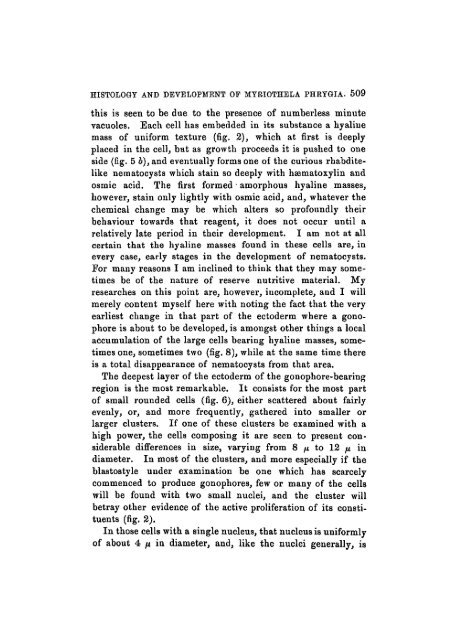supporting lamella
supporting lamella
supporting lamella
You also want an ePaper? Increase the reach of your titles
YUMPU automatically turns print PDFs into web optimized ePapers that Google loves.
HISTOLOGY AND DEVELOPMENT OF MTEIOTHELA PHRYGIA. 509<br />
this is seen to be due to the presence of numberless minute<br />
vacuoles. Each cell has embedded in its substance a hyaliue<br />
mass of uniform texture (fig. 2), which at first is deeply<br />
placed in the cell, bHt as growth proceeds it is pushed to one<br />
side (fig. 5 b), and eventually forms one of the curious rhabditelike<br />
nematocysts which stain so deeply with hsematoxylin and<br />
osmic acid. The first formed amorphous hyaline masses,<br />
however, stain only lightly with osmic acid, and, whatever the<br />
chemical change may be which alters so profoundly their<br />
behaviour towards that reagent, it does not occur until a<br />
relatively late period in their development. I am not at all<br />
certain that the hyaline masses found in these cells are, in<br />
every case, early stages in the development of nematocysts.<br />
For many reasons I am inclined to think that they may sometimes<br />
be of the nature of reserve nutritive material. My<br />
researches on this point are, however, incomplete, and I will<br />
merely content myself here with noting the fact that the very<br />
earliest change in that part of the ectoderm where a gonophore<br />
is about to be developed, is amongst other things a local<br />
accumulation of the large cells bearing hyaline masses, sometimes<br />
one, sometimes two (fig. 8), while at the same time there<br />
is a total disappearance of nematocysts from that area.<br />
The deepest layer of the ectoderm of the gonophore-bearing<br />
region is the most remarkable. It consists for the most part<br />
of small rounded cells (fig. 6), either scattered about fairly<br />
evenly, or, and more frequently, gathered into smaller or<br />
larger clusters. If one of these clusters be examined with a<br />
high power, the cells composing it are seen to present considerable<br />
differences in size, varying from 8 ft to 12 (i in<br />
diameter. In most of the clusters, and more especially if the<br />
blastostyle under examination be one which has scarcely<br />
commenced to produce gonophores, few or many of the cells<br />
will be found with two small nuclei, and the cluster will<br />
betray other evidence of the active proliferation of its constituents<br />
(fig. 2).<br />
In those cells with a single nucleus, that nucleus is uniformly<br />
of about 4 n in diameter, and, like the nuclei generally, is

















